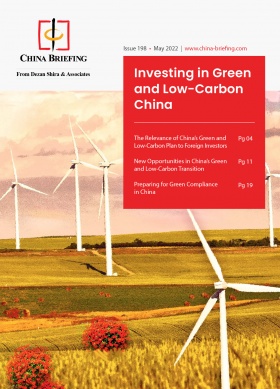Understanding China’s New Carbon Accounting Plan: Green Compliance and Opportunities
- China released a new Work Plan for Improving the Carbon Emission Statistics and Accounting System, an important supporting document for China’s dual carbon goals.
- The Work Plan specifies that China aims to build an annual and interim reporting system for carbon emissions by 2025. The clear tasks and timelines make it urgent for businesses to develop internal carbon accounting capabilities.
- Meanwhile, this also implies opportunities for certain green industry sectors, including low-carbon technology R&D, emission consulting, and carbon emission footprint calculation services.
On October 24, 2024, China released the Work Plan for Improving the Carbon Emission Statistics and Accounting System (hereinafter, the “Work Plan”), an important supporting plan aimed at achieving China’s dual carbon commitments. This Work Plan sets a cornerstone for the upcoming 15th Five-Year Plan (2026-2030) and China’s transition toward a green and low-carbon economy.
Announced by the National Development and Reform Commission (NDRC) and seven other departments, the Work Plan outlines primary goals and key tasks for the next phase. Among other targets, China aims to build:
- A national and provincial annual and interim reporting system for carbon emissions and a national greenhouse gas emission factor database by 2025.
- A comprehensive carbon emission statistics and accounting system by 2030.
Given the clear responsibilities and timelines specified in the Work Plan, rapid progress can be expected in the 2024-25 period. Businesses should develop internal carbon accounting capabilities and prepare for additional green compliance requirements.
In this article, we navigate the details of the Work Plan for China’s carbon emission statistics and accounting systems and explore potential impacts and opportunities for businesses.
Background: Building China’s carbon emission statistics and accounting system
In 2020, President Xi Jinping announced China’s intentions to expedite its voluntary carbon emissions reduction targets ahead of its pre-existing commitments and strive to reach peak carbon emissions by 2030 and carbon neutrality by 2060.
In February 2022, the State Council released the Guiding Opinions of the State Council on Accelerating the Establishment and Improvement of a Green, Low-carbon and Recycling Economic System (“Guiding Opinion”), which sets broader goals for China to transfer to a green economy.
A robust carbon emission statistics and accounting system is crucial for China’s dual carbon goals for several reasons:
- Accurate measurement and reporting: To effectively manage and reduce carbon emissions, it’s essential to have accurate data. A comprehensive system ensures that emissions are measured consistently and reported accurately at both national and provincial levels.
- Informed policy making: Reliable data allows policymakers to design and implement targeted strategies to reduce emissions. It helps in identifying the most significant sources of emissions and the sectors where interventions can be most effective.
- Tracking progress: With clear and consistent data, China can monitor its progress towards reaching peak carbon emissions by 2030 and achieving carbon neutrality by 2060. This tracking is vital for assessing the effectiveness of policies and making necessary adjustments.
- Business compliance and innovation: For businesses, a clear framework for carbon accounting helps in understanding regulatory requirements and encourages the adoption of greener practices. It also drives innovation as companies seek to reduce their carbon footprint and improve sustainability.
A well-developed carbon emission statistics and accounting system is foundational for China to achieve its ambitious dual carbon goals, ensuring that efforts are data-driven, transparent, and effective.”— Alberto Vettoretti, Managing Partner, Dezan Shira & Associates
China has been working on its carbon emission statistics and accounting system since 2022:
- The 20th Congress of the Communist Party of China proposed the “improvement of the carbon emission statistics and accounting system.”
- The Third Plenary Session of the 20th Central Committee emphasized the need to establish a new mechanism for transitioning from dual control of energy consumption to dual control of carbon emissions and to build a carbon emission statistics and accounting system.
- In July 2024, the General Office of the State Council issued the “Work Plan for Accelerating the Establishment of a Dual Control System for Carbon Emissions,” which set new requirements for improving carbon emission statistics and accounting.
- In September 2024, the market regulator (State Administration of Market Regulation), macro planner (NDRC), and environmental regulator (Ministry of Ecology and Environment) released the first-ever catalog of carbon emission measurement parameters, providing guidance on how to measure them.
Now, the Work Plan focuses on addressing critical shortcomings, further detailing tasks, solidifying responsibilities, and strengthening implementation. This will effectively promote the enhancement of carbon emission statistics and accounting capabilities across all levels, fields, and industries, improving the quality and timeliness of carbon emission data.
Objectives and timelines for building China’s carbon accounting system
According to the Work Plan:
By 2025:
- Establish a national and provincial annual and interim reporting system for carbon emissions.
- Create and periodically update a national greenhouse gas emission factor database, enhancing capabilities for measurement, detection, monitoring, and analysis of carbon emissions.
By 2030:
- Complete a comprehensive carbon emission statistics and accounting system.
- Significantly enhance carbon emission management capabilities for key energy-consuming and emission-emitting entities.
- Improve the product carbon footprint management system.
- Ensure carbon emission data effectively supports carbon emission control requirements across all levels, sectors, and industries.
Over the next decade, these frameworks will evolve into a sophisticated system that not only aligns with international standards but also enhances China’s internal carbon monitoring and control capabilities. Ultimately, the Work Plan will build the institutional capacity required to meet the carbon control demands of China’s net-zero commitments, making it a significant move toward sustainable growth and environmental responsibility.
Key tasks set in the Work Plan
As an important supporting document for establishing the dual control system for carbon emissions, the Work Plan focuses on serving local carbon assessments, industry carbon management, corporate carbon management, project carbon evaluation, and product carbon footprints. It outlines 23 specific tasks across 8 key areas.
| Key Tasks Set in the Work Plan for Building China’s Carbon Emission Statistics and Accounting System | |
| Areas | Key tasks |
| Regional level |
|
| Industry level |
|
| Enterprise level |
|
| Project level |
|
| Product level |
|
| Advanced technology and methodology research |
|
| International cooperation |
|
How should businesses prepare for China’s carbon accounting system?
Although China’s carbon emission statistics and accounting system is still developing, the clear responsibilities and timelines specified in the Work Plan suggest that rapid progress can be expected in the 2024-25 period. Businesses should develop internal carbon accounting capabilities and prepare for additional green compliance requirements starting around 2026.
Strategic adjustment
Companies should consider integrating carbon management into long-term strategies, moving beyond basic compliance to actively embedding sustainability within their core operations. This involves establishing or upgrading internal carbon emissions data management systems to track emissions accurately, identify reduction opportunities, and allocate resources toward these initiatives.
Exploring low-carbon and sustainable business models, such as energy-efficient production processes and renewable energy adoption, can help companies stay competitive and resilient. Additionally, these adjustments may involve cross-departmental collaboration to ensure that sustainability efforts align with business goals and drive innovation across the value chain.
Enhance data management
Companies should consider establishing a robust carbon database to track emissions across all activities and ensure compliance with increasingly stringent reporting requirements. They should also consider investing in training programs for employees involved in data management to enhance their capabilities in handling carbon emissions data.
Moreover, companies need to adjust their reports to meet new statistical and accounting standards, which may include sector-specific requirements. By clearly communicating carbon reduction efforts and results to investors, consumers, and other stakeholders, companies can build trust, enhance brand reputation, and potentially attract environmentally conscious investors.
Risk management
With carbon regulations intensifying, companies need to establish a regular process to assess compliance with the latest policies and legal requirements. This involves tracking updates to carbon emissions regulations and identifying emerging risks, such as potential carbon taxes, trading costs in carbon markets, and penalties for non-compliance. Companies should also evaluate the financial impact of these risks and develop tailored risk management strategies, such as investing in carbon offsets or preparing for market-based costs associated with emissions.
Opportunities in China’s carbon accounting system
China’s shift towards dual carbon controls, limiting both total emissions and carbon intensity, signals a transformative phase in its economic landscape, especially in energy and industrial sectors. This move opens up significant investment opportunities in fields like low-carbon technology research and development (R&D), carbon emissions consulting, and emissions footprint calculation services. As China sets a clear path toward sustainability, investors have a unique chance to support and benefit from the nation’s transition to green energy and sustainable practices.
Low-carbon technology R&D
As China transitions to dual carbon controls, innovation in low-carbon technology becomes a vital growth area. There is a pressing need for breakthroughs in areas like carbon capture, storage, and energy efficiency, as well as advancements in renewable energy sources, such as solar and wind.
For investors, supporting R&D in these fields offers an opportunity to shape the future of energy and sustainability while potentially capitalizing on government incentives and subsidies. Investment in low-carbon technology R&D not only positions companies to meet regulatory requirements but also strengthens their competitiveness as leaders in the global green economy.
Low-carbon emission consulting
Companies across all sectors face increasingly strict carbon emissions regulations and need expert guidance to adapt. Low-carbon emission consulting services help businesses align with new regulatory standards and devise tailored strategies for reducing their carbon footprint.
Consulting firms specializing in this area can advise on everything from emissions tracking to implementing sustainable practices, thereby creating a critical bridge between regulation and practical application. This field presents a lucrative opportunity for investors, as more companies seek assistance to navigate the complex regulatory landscape and demonstrate their commitment to environmental responsibility.
Carbon emission footprint calculation services
Calculating and reporting carbon emissions is essential for compliance with carbon controls as well as for maintaining transparency with stakeholders. Carbon emission footprint calculation services will be needed to offer expertise in measuring emissions across a company’s entire value chain, from raw materials to end products. This field is likely to expand as demand grows for detailed emissions data, both for regulatory compliance and voluntary sustainability reporting.
Investors in this sector can benefit from the increasing importance of data accuracy in emissions reporting, especially as businesses seek to enhance their environmental accountability and attract eco-conscious consumers and investors.
About Us
China Briefing is one of five regional Asia Briefing publications, supported by Dezan Shira & Associates. For a complimentary subscription to China Briefing’s content products, please click here.
Dezan Shira & Associates assists foreign investors into China and has done so since 1992 through offices in Beijing, Tianjin, Dalian, Qingdao, Shanghai, Hangzhou, Ningbo, Suzhou, Guangzhou, Haikou, Zhongshan, Shenzhen, and Hong Kong. We also have offices in Vietnam, Indonesia, Singapore, United States, Germany, Italy, India, and Dubai (UAE) and partner firms assisting foreign investors in The Philippines, Malaysia, Thailand, Bangladesh, and Australia. For assistance in China, please contact the firm at china@dezshira.com or visit our website at www.dezshira.com.
- Previous Article E-Commerce in China as Part of a Digital Revolution
- Next Article China Monthly Tax Brief: October 2024

























